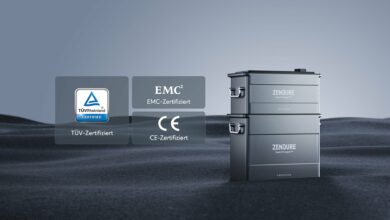
In 2024, China will open a new chapter in solar energy: a twin-tower solar power plant with 30,000 mirrors is set to begin operation. This innovative plant promises to significantly increase the efficiency of solar energy generation and could lead the way for future projects worldwide.
The most important facts in brief
- China’s twin-tower solar power plant uses 30,000 mirrors.
- The power plant is due to go into operation at the end of 2024.
- The technology promises increased efficiency in solar energy generation.
- This project could serve as a model for future solar power plants.
Innovative solar power plant for more solar energy
The twin-tower solar power plant is based on solar thermal technology. A report in futurezone explains how this works. Sunlight is bundled with the help of mirrors to generate heat. This heat is then used to generate steam, which in turn drives a turbine and produces electricity. The special feature of this power plant is the use of two towers, which are illuminated by a total of 30,000 mirrors.
These mirrors, also known as heliostats, track the position of the sun and reflect the light onto the tops of the towers, where it is converted into heat. Unlike previous plants based on solar thermal energy, the new power plant in China uses two towers but only one generator, as reported by CGTN. This is intended to ensure greater efficiency in terms of energy yield. Compared to other plants with two towers, an increase of 24 percent should be possible.
Dual-tower design helps to generate solar energy
The dual-tower design enables a more even distribution of solar energy, which leads to greater efficiency. Traditional solar power plants with only one tower often have the problem that the solar radiation is not optimally utilized. This is particularly the case in changing weather conditions.
By using two towers, this new solar power plant can capture and use the energy better. This not only leads to higher electricity production, but also to a more stable energy supply.
Technical details and advantages
The power plant’s 30,000 mirrors are able to align themselves precisely with the sun, minimizing energy loss. Each mirror is computer-controlled and can calculate and set the optimum angle to the sun. Another advantage of the twin tower design is redundancy. Should one of the towers fail or require maintenance, the other tower can continue to generate energy.
This increases the reliability and operational safety of the system. However, there is one disadvantage – it takes up a lot of space. The structure measures just under 110 soccer pitches. But it is worth it. According to a report by t3n, around 250 plants of this type would be enough to cover Germany’s entire electricity consumption. They produce just under 1.8 terawatt hours of energy per year.
Future prospects for solar energy
The twin-tower solar power plant in China could serve as a model for future solar projects worldwide. The increased efficiency and reliability make this technology particularly attractive for regions with high levels of solar radiation. The project also contributes to the reduction of greenhouse gas emissions and supports China’s goals to combat climate change.
China’s commitment to developing such technologies also demonstrates the increasing importance of renewable energy on a global scale. While many countries still rely heavily on fossil fuels, China is setting a strong example for the shift towards sustainable energy sources.
Conclusion
The new twin-tower solar power plant in China marks a significant advance in the use of solar thermal energy. With 30,000 mirrors and an innovative dual-tower design, the plant promises greater efficiency and reliability. This project could serve as a model for future solar power plants and represents an important step towards a more sustainable energy future. The power plant will go into operation at the end of 2024.



